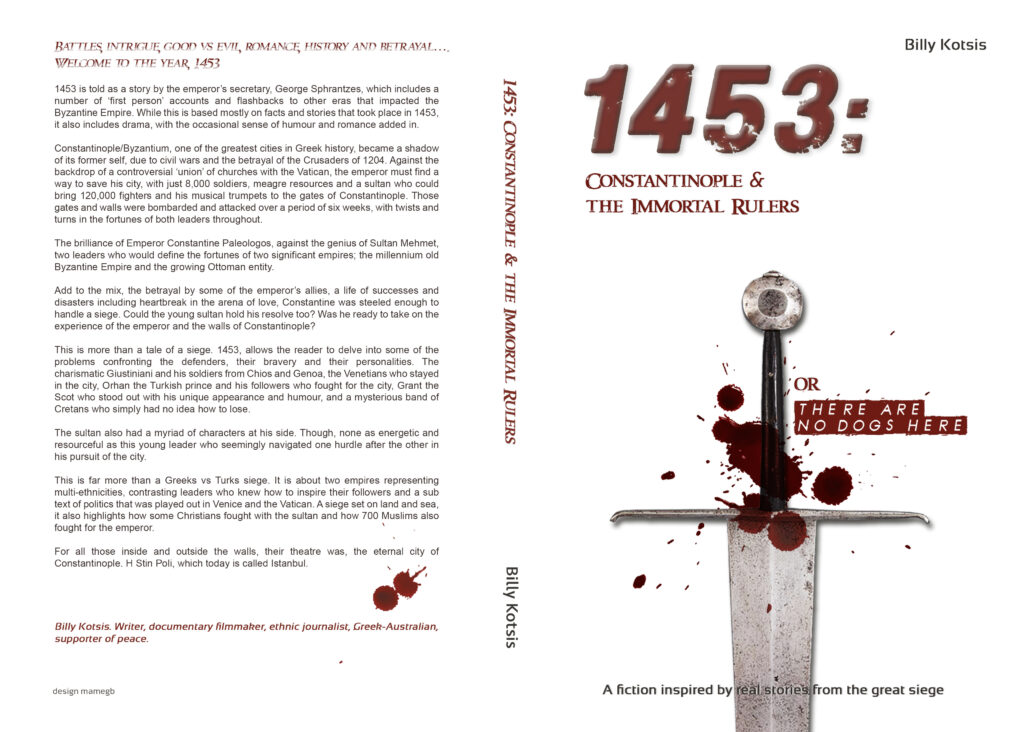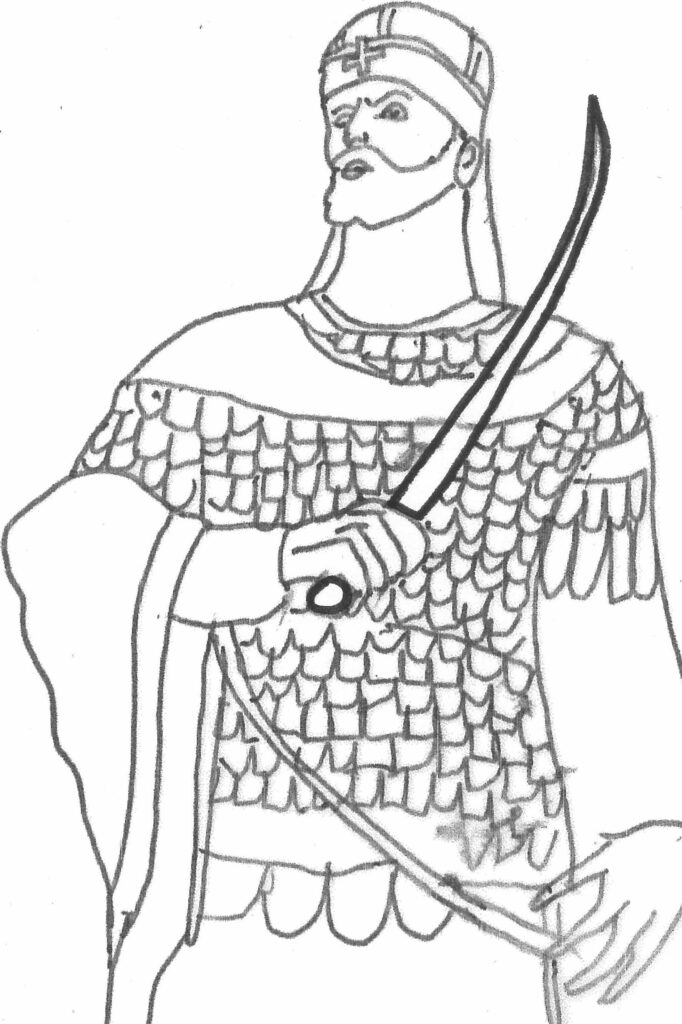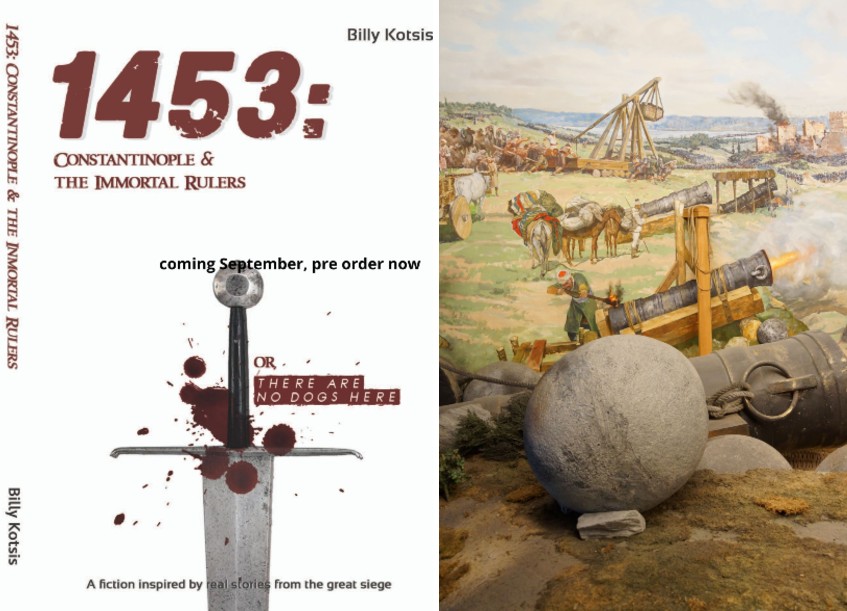1453: Constantinople and the Immortal Rulers is told as a story by the emperor’s secretary, George Sphrantzes, which includes a number of ‘first person’ accounts and flashbacks to other eras that impacted the Byzantine Empire. While this is based mostly on facts and stories that took place in 1453, it also includes drama, with the occasional sense of humour and romance added in.
This is the fifth book from Billy Cotsis, whose previous efforts include the acclaimed Many Faces of Hellenic Culture and Once upon a time in Crystal Palace. The latter is set to be turned into a film if finance is secured.
Billy has also just completed work on a documentary trilogy, “Magna Graecia” set in Calabria and Apulia about the Greek speaking villages in Italy. Whilst in Italy, he also directed “An Olive Tale,” which takes in the world of olives across the south of Italy, as well as the Peloponnese and Lesvos. Channel 44 Adelaide will be playing this two part series in early October, and Foxtel shortly after. This was a production in conjunction with Mimmo Lubrano, Sandhurst Fine Foods.

With the recent controversy about converting Hagia Sofia to a mosque, after almost a century as a museum, the book is well timed, though not deliberate.
It was a labor of love.
“I had started writing this as a screenplay when I was in London, years ago, and never finished it. Thanks to Covid, I had time to write this a book. One good aspect of the lockdown!” Cotsis says.
Synopsis:
Constantinople/Byzantium, one of the greatest cities in Greek history, became a shadow of its former self, due to civil wars and the betrayal of the Crusaders of 1204. Against the backdrop of a controversial ‘union’ of churches with the Vatican, the emperor must find a way to save his city, with just 8,000 soldiers, meagre resources and a sultan who could bring 120,000 fighters and his musical trumpets to the gates of Constantinople. Those gates and walls were bombarded and attacked over six weeks, with twists and turns in the fortunes of both leaders throughout.
The brilliance of Emperor Constantine Paleologos, against the genius of Sultan Mehmet, two leaders who would define the fortunes of two significant empires; the millennium old Byzantine Empire and the growing Ottoman entity.

“This is more than a tale of a siege. 1453, allows the reader to delve into some of the problems confronting the defenders, their bravery and their personalities. The charismatic Giustiniani and his soldiers from Chios and Genoa, the Venetians who stayed in the city, Orhan the Turkish prince and his followers who fought for the city, Grant the Scot who stood out with his unique appearance and humour, and a mysterious band of Cretans who simply had no idea how to lose.”
As the era seems devoid of women and their role, the book sees the entry of four female characters, with each one having an impact on the events that unfold.
“Women, monks, civilians, they were all at the walls helping the 8,000 defenders. The book hopefully shows that it was just male soldiers who defended the great city.”
This is far more than a Greeks vs Turks siege. It is about two empires representing multi-ethnicities, contrasting leaders who knew how to inspire their followers and a sub text of politics that was played out in Venice and the Vatican. Some of the great characters in the siege were Italian. The support of some of the Genoans and Venetians was crucial, yet it was also the lack of support from Venice and to an extent the pope, that proved almost detrimental. “Venice and the pope were slow to respond or responding only in a context that the Greeks must come under the papacy.”

“I hope that I was able to humanise some of the characters/people involved in the siege. It is a fiction based on facts, though I had to create the female characters, as there is very little information on the women in this era. I have told the tale through a main narrator, some flashbacks to golden moments of the empire and of course, the lead up to 29 May, 1453.”
To add some intrigue, there is also an alternative ending, a ‘what-if’ scenario.
As always with a book from Billy, there are proof readers from around the world, the graphic designer is a friend in Argentina, and the two love scenes in the book are written by a Greek speaking Brasilian in Brasil.
1453: Constantinople and the Immortal Rulers is available on Amazon and the Greek Bilingual Bookshop week 2 of September https://bilingualbookshop.com.au/ and wherever a good book may or may not be sold, including Kingsgrove and Belmore newsagents.
Launch by zoom is coming on 28 October, to coincide with Oxi Day.
Billy Cotsis is a writer, documentary filmmaker, ethnic journalist, supporter of peace. His next project is a documentary series called Magna Graecia, which takes us to the Greek villages of Calabria and Apulia in Italy.

